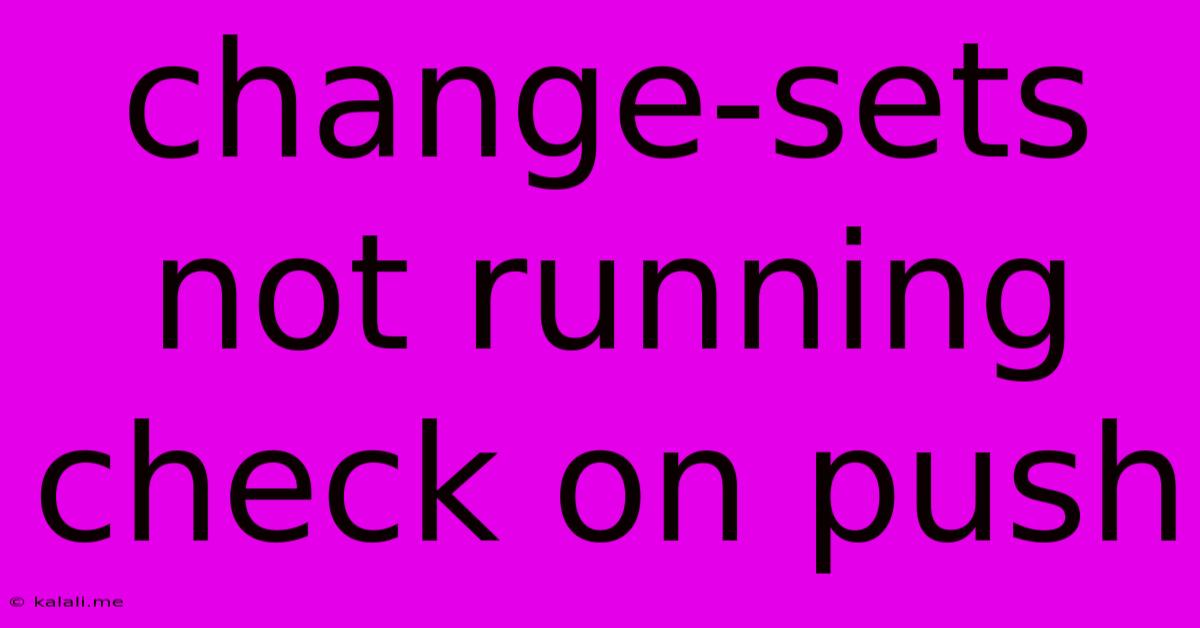Change-sets Not Running Check On Push
Kalali
Jun 02, 2025 · 3 min read

Table of Contents
Change-Sets Not Running Check on Push: Troubleshooting and Solutions
Are your change sets in Salesforce failing to trigger checks on push? This frustrating issue can significantly slow down your development workflow and introduce potential risks into your production environment. This article delves into the common causes behind this problem and provides practical solutions to get your change sets running smoothly. We'll cover everything from verifying basic setup to exploring more advanced troubleshooting techniques.
Understanding the Problem: A change set's purpose is to move metadata between Salesforce orgs. The "check" process verifies the changes before deployment, flagging potential conflicts or errors. When this check fails to execute, deployments become unpredictable and potentially damaging.
Common Causes and Solutions:
1. Incorrect Change Set Configuration:
- Problem: The most frequent cause is an improperly configured change set. This includes selecting the wrong target organization, missing components, or incorrect deployment settings.
- Solution: Carefully review the change set's configuration. Double-check the target organization's details, ensure all necessary components are included, and verify the deployment options. A thorough review of the components included, especially custom objects, fields, and Apex classes, is vital. Pay close attention to the "Deploy to" and "Test Settings" sections.
2. Permissions Issues:
- Problem: Insufficient permissions in either the source or target org can prevent the change set from running a proper check. The user deploying the change set must possess the necessary rights to access and manipulate the components involved.
- Solution: Verify that the user deploying the change set has the appropriate Deploy to and Modify All Data permissions on the target org. In the source org, ensure the user has the permissions required to retrieve and package the selected components.
3. Component Dependencies:
- Problem: Missing or incorrectly ordered dependencies between components can result in the check failing. For example, if you're deploying a custom controller and the corresponding visualforce page isn't included, the check will likely fail.
- Solution: Use the Salesforce Developer Console or other tools to thoroughly analyze the dependencies between your components. Ensure all necessary components are included in the change set, and review their order for proper deployment. Consider using a tool like Ant Migration Tool for more control over deployment order and dependency management. Understanding Apex dependencies and Visualforce page references is crucial for success here.
4. Sandbox Issues:
- Problem: If deploying to a sandbox, the sandbox might not fully replicate the production environment's configuration, leading to unexpected errors. API limits could also affect a proper deployment check.
- Solution: Ensure your sandbox is a fully refreshed copy of production or at least contains the necessary components for your change set. Review the sandbox's settings, API limits, and available resources. If API limits are exceeded, consider deploying the change set in smaller batches.
5. Salesforce Platform Issues:
- Problem: Occasionally, temporary issues with the Salesforce platform itself can interfere with change set deployment. These are typically less common but should be considered if other solutions fail.
- Solution: Check the Salesforce Trust status page for any reported outages or performance issues that might be affecting your deployment. Contact Salesforce support if necessary.
6. Testing and Debugging:
- Problem: Failing to thoroughly test the change set in a lower environment before deployment to production can lead to unexpected deployment errors.
- Solution: Always deploy and test your change set in a lower environment, such as a developer sandbox, before deploying to production. This allows you to identify and resolve issues before they reach production.
Best Practices:
- Use smaller, more focused change sets: This reduces the chances of conflicts and makes debugging easier.
- Regularly refresh your sandboxes: Keeps your sandbox environment up-to-date and minimizes discrepancies.
- Leverage the Salesforce DX command line interface: Offers better control over deployment and error logging.
By systematically checking these aspects, you significantly increase your chances of successfully deploying your change sets and maintaining a robust Salesforce development process. Remember that meticulous planning and thorough testing are key to avoiding common pitfalls.
Latest Posts
Latest Posts
-
What To Do If Turkey Is Done Too Soon
Jun 04, 2025
-
What Do Different Divisions Mean I Modeli Ng
Jun 04, 2025
-
What Color Should Power Steering Fluid Be
Jun 04, 2025
-
How Can You Tell If Battery Or Alternator Is Bad
Jun 04, 2025
-
Air Conditioner Blowing Cold Air Outside
Jun 04, 2025
Related Post
Thank you for visiting our website which covers about Change-sets Not Running Check On Push . We hope the information provided has been useful to you. Feel free to contact us if you have any questions or need further assistance. See you next time and don't miss to bookmark.